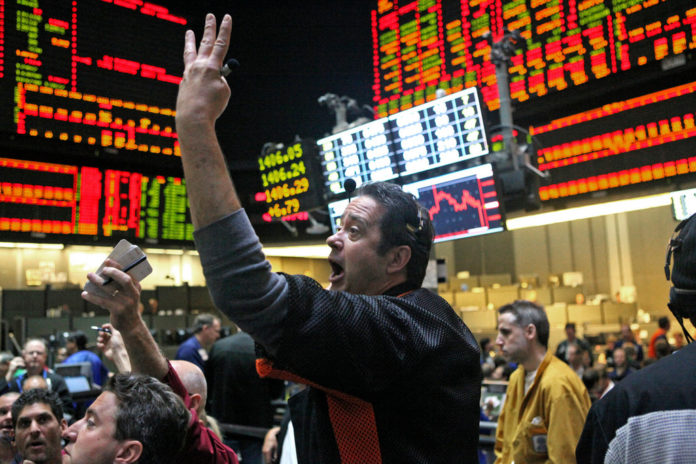
NEW YORK – U.S. stocks fluctuated, after the Standard & Poor’s 500 Index hit a record yesterday, as investors weighed disappointing manufacturing data and earnings from companies including Travelers Cos. and Texas Instruments Inc.
Travelers tumbled 3.1 percent after posting the biggest quarterly decline since 2008 in a key measure of the company’s value as higher interest rates pressured its bond portfolio. Netflix Inc. dropped 5.8 percent amid slower-than-expected subscriber gains. Texas Instruments climbed 3.9 percent after forecasting sales and profit that may exceed estimates.
The S&P 500 slid 0.1 percent to 1,693.47 at 12:38 p.m. in New York. The Dow Jones Industrial Average gained 24.15 points, or 0.2 percent, to 15,569.70. Trading in S&P 500 stocks was 2.4 percent below the 30-day average during this time of day.
“What you’re seeing is revenues are coming in pretty lackluster and profits seem to be doing a little better than gains in sales,” Hank Herrmann, Overland Park, Kansas-based chief executive officer of Waddell & Reed Investment Management Co., said by phone. His firm manages $104 billion. “The market had a period of digesting the confusion over Fed tapering. For the moment, it’s focused on individual company fundamentals.”
The S&P 500 extended a record yesterday, adding to a rally from last week after Fed Chairman Ben S. Bernanke said the central bank remains flexible about the duration of its asset- purchase program. The index dropped as much as 5.8 percent after Bernanke signaled on May 22 that the Fed could start scaling back bond purchases as soon as September.
Fed stimulus has helped fuel a surge in stocks worldwide, with the S&P 500 jumping as much as 151 percent from its March 2009 low.
Manufacturing data
The benchmark equity gauge erased earlier gains of as much as 0.2 percent today after the Richmond Fed’s index of manufacturing in the mid-Atlantic region unexpectedly fell in July. The factory index slid to minus 11. Readings greater than zero signal expansion in the region that includes the Carolinas, the District of Columbia, Maryland, Virginia and West Virginia. The median projection in a Bloomberg survey of economists called for a reading of 9.
Investors have been weighing data to determine the timing and pace of any stimulus reduction by the Fed. Half of the economists in a July 18-22 Bloomberg survey expect the central bank to trim at its September meeting the pace of its monthly bond buying to $65 billion from the current $85 billion. That’s up from 44 percent in last month’s poll.
‘Low risk’
“The big step the market has made is that the market now accepts that it needs to be prepared for the Fed beginning to taper sometime in the next four to five months,” Joseph Veranth, chief investment officer at Dana Investment Advisors in Brookfield, Wisconsin, said by phone. The firm manages $4.2 billion. “People have accepted a low growth scenario for the U.S., but they also see it a low risk market. The U.S. market is guardedly healthy.”
In Asia, Chinese Premier Li Keqiang said the slowest economic growth policy makers will tolerate is 7 percent, Beijing News reported. China, the world’s second-largest economy, is the biggest consumer of energy and raw materials.
Investors have also increasingly turned their attention to earnings, with 35 S&P 500-listed companies, including Apple Inc. and AT&T Inc., releasing results today. Of the 130 companies on the gauge to have already reported, 71 percent have beat analysts’ profit estimates while about 52 percent have surpassed revenue expectations, data compiled by Bloomberg show.
Volatility gauge
The Chicago Board Options Exchange Volatility Index, or VIX, jumped 2.9 percent today to 12.65, snapping a streak of four straight declines. The equity volatility gauge, which moves in the opposite direction as the S&P 500 about 80 percent of the time, reached a six-year low in March and has since surged 12 percent.
Six of 10 S&P 500 main industries fell, with health-care , consumer-staples and financial shares retreating at least 0.3 percent to lead losses.
Travelers, the second-largest U.S. commercial insurer, dropped 3.1 percent to $82.78 for the biggest retreat in the Dow. Book value, a measure of assets minus liabilities, slipped to $66.65 per share from $68 three months earlier, the company said today in a regulatory filing as it announced second-quarter results. The decline was driven by a $1.77 billion drop in net unrealized gains in its $62.8 billion portfolio of fixed- maturity securities.
Netflix slumped 5.8 percent to $246.77 after saying it added 630,000 new U.S. customers for its Internet TV service in the second quarter, fewer than the average analyst projection of 700,000. The company forecast earnings of 30 cents to 56 cents a share in the third quarter, while the average analyst estimate called for 43 cents. Netflix shares have surged 183 percent this year through yesterday.
Waters Corp. slipped 5.9 percent to $99.15. The maker of laboratory products and instruments cut its full-year earnings forecast to a range of $5 to $5.10 a share. Analysts had estimated $5.21, according to the average estimate.
Broadcom Corp. dropped 3.3 percent to $32.14. The maker of chips that help mobile devices connect to the Internet may be losing its market share, Michael McConnell, an analyst with Pacific Crest Securities LLC., said in a note. He cut the stock’s rating to sector perform, an equivalent of neutral, from outperform. The company is due to report results after the market close today.
Menthol cigarettes
Tobacco companies fell. The industry may face limits on selling menthol cigarettes in the U.S. after regulators determined the minty flavoring may encourage people to start smoking. Lorillard Inc. dropped 4.4 percent to $44.13. Altria Group Inc. retreated 2.4 percent to $35.99.
Texas Instruments climbed 3.9 percent to $38.87 after forecasting third-quarter sales of $3.09 billion to $3.35 billion. Analysts on average had forecast $3.2 billion. The world’s largest analog-chip maker predicted earnings will reach 49 cents to 57 cents a share, according to a statement. Analysts had projected 51 cents.
United Technologies Corp. gained 2.5 percent to $104.61. The company boosted the lower end of its 2013 profit forecast after rising demand for jet engines and aerospace components helped second-quarter earnings exceed analysts’ estimates.
Lockheed Martin Corp. added 2.3 percent to $118.34. The world’s largest defense contractor raised its full-year profit forecast as it reported second-quarter earnings that beat analysts’ estimates. Profit rose at the Lockheed divisions that make missiles and provide training and logistics services, while it fell at the aeronautics unit.
Surprise profit
Peabody Energy Corp. added 6.9 percent to $17.45 for the biggest gain in the S&P 500. The largest U.S. coal producer reported a surprise profit and forecast lower mining costs.
Wendy’s Co. jumped 11 percent to $7.41 after the fast-food chain reported earnings that beat estimates and boosted its dividend. The company said it will sell 425 restaurants to franchisees while reducing company ownership to around 15 percent from 22 percent.
Sourcefire Inc. rallied 28 percent to $75.47. Cisco Systems Inc., the biggest maker of networking equipment, agreed to acquire the cyber security company for about $2.7 billion. Cisco slid 0.1 percent to $25.68.
CapitalSource Inc. surged 22 percent to $12.01 after PacWest Bancorp. said it agreed to buy the lender in a deal that will create California’s eighth-biggest commercial bank. CapitalSource investors will get about $11.64 a share in PacWest stock and cash, according to a joint statement.












